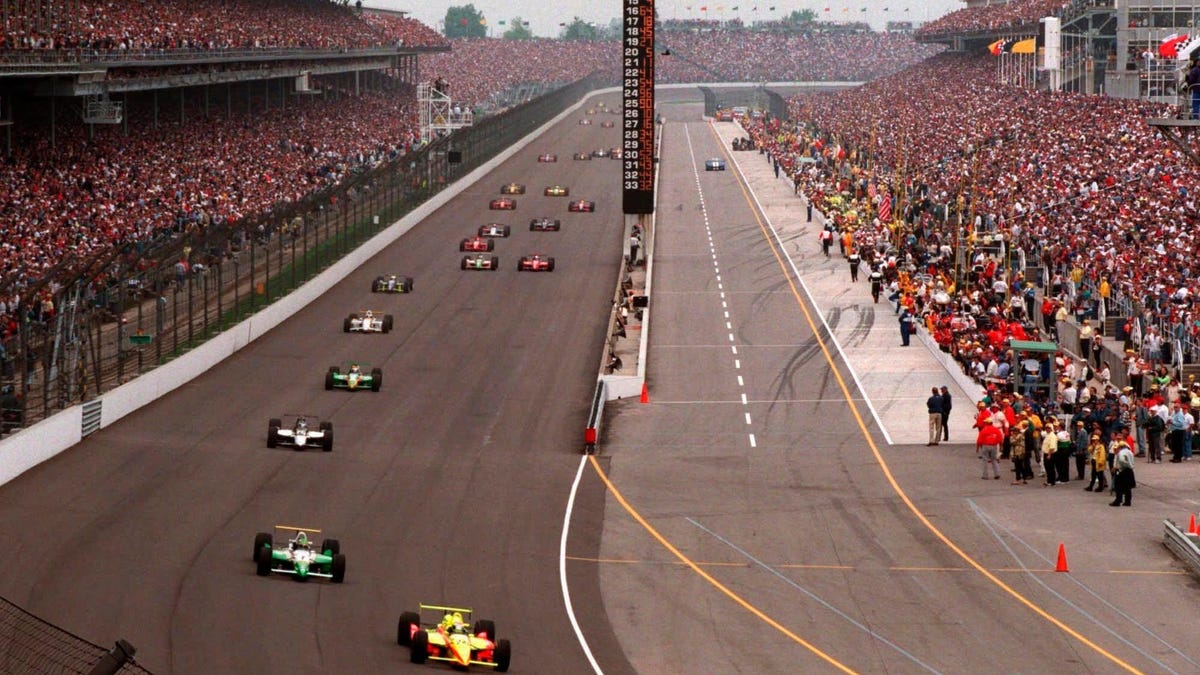Indianapolis 500 vs. U.S. 500: The Year American Open-Wheel Racing Split in Two

Tony Stewart leads the field at the 1996 Indianapolis 500.Photo: Amy Sancetta (AP)
In 1996, the Indianapolis 500 was a very different affair than it had in the past. About 230 miles northeast, at Michigan International Speedway, a rival race was set to take place, and it was called the U.S. 500.
When you think “open-wheel racing on Memorial Day weekend,” you think “Indy 500.” But in 1996, tensions were high. After years of contention and fracturing, American open-wheel racing had split again, this time putting the newly-founded Indy Racing League (IRL) against Championship Auto Racing Teams (CART).
At the time, Tony George served as president of the Indianapolis Motor Speedway, and in his other role as IRL co-founder, he made an executive decision. Of the traditional field of 33 cars, 25 slots were guaranteed for IRL entries — leaving just eight slots for a full field of CART machines to qualify for the biggest race in America.
As you can imagine, that announcement didn’t exactly sit well with CART; the Indy 500 had long been a unifying race for American open-wheel racers no matter how many fractured series were operating. The 500, after all, has traditionally been something of an outlier, one that carries more historical heft and financial reward than other events.
But George, who took over the Speedway in 1994, knew that CART entries would likely dominate the 500. Teams included powerhouses like Penske, Chip Ganassi Racing, Newman-Haas Racing, and Team Rahal, while driving stars included Michael Andretti, Al Unser Jr., Jimmy Vasser, and Alex Zanardi. Give those drivers and teams a chance to take on the Indy 500, and it was almost guaranteed that Tony George’s series would look foolish compared to CART.
G/O Media may get a commission
24% Off
Braun Electric Razor for Men
Clean
Has a special flexible head to hit everywhere you need it to, has a variety of different functions to use to fit your preferred style, and is designed to last seven years.
CART decided it wouldn’t take the slight sitting down. Instead, the organization decided to take advantage of Penske-owned Michigan International Speedway to launch an event that would directly compete with the Greatest Spectacle in Racing — the U.S. 500. Just to sweeten the pot, the CART schedule included a qualifying session the weekend before the event, intended to steal eyes from Indy 500 qualifying.
To say that the rebellious 1996 U.S. 500 wasn’t a success might be an understatement. Despite the exclusion of CART racers, the 80th Indy 500 still managed to run a full field of 33 cars while the U.S. 500 only saw 25 entries.
Things only got worse from there. A massive crash on the first lap of the U.S. 500 saw polesitter Jimmy Vasser struck by Adrian Fernandez. Fernandez hit Bryan Herta, and the resulting chaos destroyed 10 cars. To make matters worse, CART allowed teams to replace the wrecked cars with backups — something that never would have been allowed at the Indy 500. For CART, it was a lose-lose situation: Having so many cars drop out on the opening lap would have basically guaranteed a dull race; letting those drivers re-enter in backup cars meant CART was manipulating the natural evolution of the race, which would hurt the series’ credibility with fans.
Vasser would ultimately go on to win the race, along with the $1 million prize. Meanwhile, a nobody named Buddy Lazier took victory at the Indianapolis 500.
The U.S. 500 didn’t stick around as a Memorial Day race; CART opted against hosting the event again, and the series’ cars didn’t return to Indianapolis until 2000. In 1997, IRL introduced new chassis and engine regulations, meaning that any CART team interested in competing at the Indy 500 would need to purchase a brand-new car just to race in that single event.
It was a dark time in American open-wheel history; rather than capitalizing on the sport’s popularity, infighting caused a split that wiped out an avid fanbase for years to come. The fate of American open-wheel looked rather like the respective 500s: A massive crash, a no-name winner, and a fanbase torn in two.



